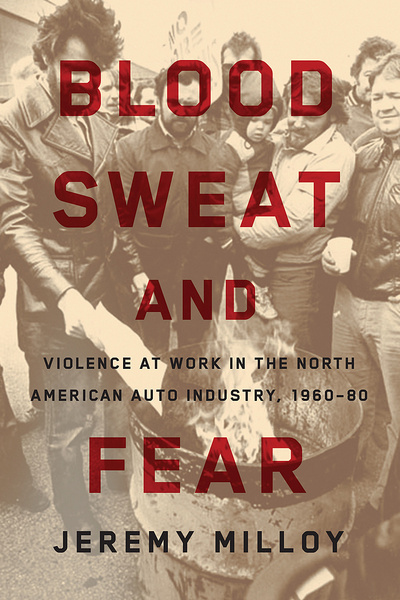Q&A with Jeremy Milloy, author of Blood, Sweat, and Fear
Posted: Wednesday, December 06, 2017 
Blood, Sweat, and Fear is the first full-length historial explaration of the origins and effects of individual violence in the automotive industry. Author Jeremy Milloy to gave us a behind-the-scenes look at this important book.
Why were you interested in writing a book about violence in the workplace?
Mark Ames’s 2005 book Going Postal: From Reagan’s Workplaces to Clinton’s Columbine and Beyond was a key inspiration that got me thinking about whether workplace violence was an issue before the 1980s and 90s tragedies that Ames chronicled. I learned that yes, violence was a major factor in many peoples’ workplaces historically. Workplace violence didn’t arise in the 1980s, it shifted and attracted a new level of interest from the mass media, governments, and employers. One thing that struck me about how violence at work changed: in the early 20th century, people often brought weapons to work and labour disputes to protect themselves from employers and their muscle; by the end of the 20th century, there was a push for workers to be able to bring weapons to work to protect themselves from their fellow workers. I became fascinated with trying to figure out this shift. I looked at the auto industry because it was one of the most important industries in North America, and it allowed me to make contrasts and comparisons across the Canada-U.S. border. I soon learned violence was a significant factor in auto workplaces during the 1960s and 1970s.
What prompted the violence?
First, these were dangerous, contentious places to work. In Windsor and especially Detroit, workers were pushed to their limits to get the maximum amount of cars out the door each shift. In Detroit, racism was a major part of the labour process - the workers pushed the hardest in the worst jobs were often Black, a process radical workers called “Niggermation.” This exploitative labour process, based on racial exploitation in the case of Detroit, was the major cause of the daily frustration and conflict that produced violence. Finally, masculine status at the plant was often connected with physical strength and physical violence.
How do you see capitalism playing a role in the violence?
Capitalism didn’t just play a role in the violence - much of the violence at the plant was capitalism’s violence. I say that not to absolve individual workers that committed violent acts of their responsibility for their actions. Rather, I want to stress that much of the violence came from the labour process and its resulting conflict between worker and employers. And that conflict is not accidental - it’s baked into the framework of capitalism, where it’s in the boss’s interest to extract as much work and value from a worker as possible, and not as much in the worker’s interest, especially if they are working in conditions that are unsafe, exploitative, racist, or sexist. Violence at work is not an aberration - much of it flows from the way we’ve set up our workplaces and our society.
What about class and gender?
Primarily, this violence is an example of class conflict. It shows us how class conflict, and the experience of class, shifted in the twentieth century, from ways that were connected to a larger group - the late 19th and early 20th century violence of strikes and riots - to a more individual, atomized experience of class, and therefore individualized workplace violence.
This violence intersected with gender in three important ways. First, some violence at work was violence against women, including sexual harassment, sexual assault, and domestic violence in a workplace setting, which is today the most common form of workplace violence. Second, violence was connected with the rules and performances of masculinity - workers used violence to prove, defend, or police their masculinity. Women also employed violence at work, but it does not seem to have been a way they could access status or respect, in the way that male violence could. This indicates that the connection between masculinity and violence was to an extent learned, which suggests that this connection can be downplayed and unlearned - it’s not inevitable.
How is this relevant today?
Unfortunately, we live in a world where outbreaks of spectacular, deadly, seemingly random violence are common. It seems we are every week asking “why?” after another violent tragedy. This history encourages us to place violence in its historical context, and appreciate how much violence, even subtle and unremarked, shapes our surroundings, for example our workplaces. For example, what are the larger factors beyond individual psychology that work to raise the risk of violence at work? In Detroit in the 1960s and 70s, exploitative work, racism, and unsafe conditions were all factors heightening the risk of violence. This is actually good news - if workplace factors can raise the risk of workplace violence, it means we can reduce the risk of violence at work if we’re willing to make changes in the workplace.
Is there anything controversial about your book?
Blood, Sweat, and Fear asks us to look beyond the psychology of an individual to understand why violence happens. It asks us to, instead of condemnation of violent individuals, which is easy but ultimately not very productive, understand and make changes in the way we organize our work and our workplaces, which is a lot more difficult but has a lot more potential.
